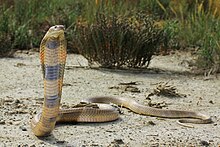| Cobra | |
|---|---|

| |
| Caspian cobra, Naja oxiana hooding in a defensive posture | |
| Scientific classification | |
| Kingdom: | |
| Phylum: | |
| Subphylum: | |
| Class: | |
| Order: | |
| Suborder: | |
| Family: | |

Cobra is the common name of various species of snake, most of them dangerously venomous, and most of them capable of flattening the neck into a so-called "hood" as a defensive threat. Most species are in the family Elapidae, and most of those are the so-called "true cobras", which comprise the genus Naja.[1] [Note 1]
Two non-venomous species of snake, the hognosed snake and the striped keelback, also rear and produce hoods but are not considered "cobras"; likewise, some venomous elapid snakes such as the black mamba also are capable of producing hoods but are not called "cobras". all of which are venomous and many of which are capable of hooding — rearing and producing a hood when threatened. All members of the genus Naja, the "true" cobras, rear and produce obvious hoods, though not all have equally broad hoods. Other "cobra" genera and species are as follows:
The following species are not in the genus Naja but are hooding, venomous members of the family Elapidae:
- The rinkhals, or ring-necked spitting cobra Hemachatus haemachatus, which spreads a broad, cobra-like hood
- The king cobra, Ophiophagus hannah, which has a narrower hood than most cobras
- The two species of tree cobra, Pseudohaje goldii and Pseudohaje nigra with only a slightly spreading hood
- The two species of shieldnose cobras, Aspidelaps lubricus and Aspidelaps scutatus with a narrower hood than most cobras
- The two species of black desert cobra, Walterinnesia aegyptia and Walterinnesia morgani, neither of which rears or produces a hood
- The so-called American cobra, the Eastern coral snake, Micrurus fulvius, which also does not rear or produce a hood
The false water cobra, Hydrodynastes gigas, is the only "cobra" which is not a member of the Elapidae. It does not rear, produces only a slight flattening of the neck, and is only mildly venomous.
Notes
edit- ^ Note however, that at times some taxonomists have proposed splitting Naja into more than one genus,whereas others regard the proposed new genera as subgenera within Naja. See for example Boulengerina.
References
edit- ^ Robert Alan Lewis (23 March 1998). Lewis' Dictionary of Toxicology. CRC Press. pp. 292–. ISBN 978-1-56670-223-2.
- ^ Murray Wrobel (4 December 2004). Elsevier's Dictionary of Reptiles. Elsevier. pp. 339–. ISBN 978-0-08-045920-2.